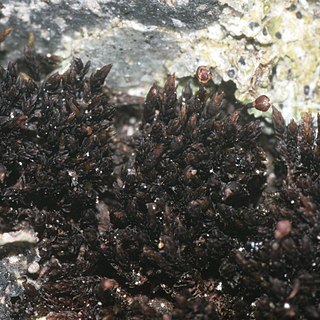Plants reddish black, black or greenish brown. Leaves curved or secund to straight, wide-spreading to squarrose, short-lanceolate, widest proximally, apex oblique or symmetric; costa absent; leaf margins entire; basal laminal cells short-to long-rectangular, marginal cells rounded-quadrate to short-rectangular, walls sometimes thickened, usually pitted, straight; medial laminal cells quadrate to short-rectangular, 1-stratose or occasionally 2-stratose in patches, lumens rounded, rectangular or irregularly stellate; laminal papillae usually present, commonly large, whitish. Sexual condition cladautoicous or autoicous; perichaetial leaves differentiated, convolute-sheathing. Spores 20-32(-50) µm.
Plants small, red-brown, forming cushions. Stems 5-20 mm long, irregularly branched. Leaves ovate to oblong-lanceolate; apex acute to obtuse; margins entire, incurved; costa absent. Upper laminal cells quadrate, incrassate, smooth to strongly papillose; basal cells linear to rectangular. Capsule just exserted, pseudopodia 1-2 mm long. Spores weakly papillose. A. rupestris is most easily identified by its red-brown colour, ecostate leaves and frequently papillose leaf cells.

